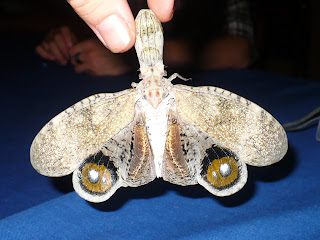Butterflies & Moths
Sections of our course examined the high productivity and biodiversity of tropical ecosystems. Insects are a huge part of rainforest function, and were everywhere in all shapes and sizes. We set up white sheets with fluorescent lights shining on them to attract moths at night, and went on butterfly walks during the day. On one such 30-minute walk I saw about 30-40 different species of butterflies in a 100m stretch of dirt road! Here are some of the more notable specimens:
 Morpho peleides - Blue morpho. Everyone on the trip wanted a photo of this large spectacular butterfly; I knew I just needed patience. Sometimes seen flying through the rainforest undercanopy, the metallic blue color is unmistakable- I followed this one for about half an hour before it landed on a leaf in the sun. Needless to say I was pretty excited!
Morpho peleides - Blue morpho. Everyone on the trip wanted a photo of this large spectacular butterfly; I knew I just needed patience. Sometimes seen flying through the rainforest undercanopy, the metallic blue color is unmistakable- I followed this one for about half an hour before it landed on a leaf in the sun. Needless to say I was pretty excited!
 Morpho peleides - Blue morpho. Everyone on the trip wanted a photo of this large spectacular butterfly; I knew I just needed patience. Sometimes seen flying through the rainforest undercanopy, the metallic blue color is unmistakable- I followed this one for about half an hour before it landed on a leaf in the sun. Needless to say I was pretty excited!
Morpho peleides - Blue morpho. Everyone on the trip wanted a photo of this large spectacular butterfly; I knew I just needed patience. Sometimes seen flying through the rainforest undercanopy, the metallic blue color is unmistakable- I followed this one for about half an hour before it landed on a leaf in the sun. Needless to say I was pretty excited! Pseudosphinx tetrio - Hawk moth. This one was about 7 inches long, with yellow stripes hidden on its abdomen- the "747 of the insect world" as Larry put it.
Pseudosphinx tetrio - Hawk moth. This one was about 7 inches long, with yellow stripes hidden on its abdomen- the "747 of the insect world" as Larry put it.
 Caligo memnon - Owl butterfly. This one was slowly flapping its wings for several minutes- I got to capture the pretty steel blue color of the interior as well as the striking eyespot patterns on the outside.
Caligo memnon - Owl butterfly. This one was slowly flapping its wings for several minutes- I got to capture the pretty steel blue color of the interior as well as the striking eyespot patterns on the outside. Adhaemarius gannascus
Adhaemarius gannascus Heraclides thoas - King swallowtail. I found this under a leaf on a night hike- what a rare find to see a diurnal species' nocturnal hiding spot!
Heraclides thoas - King swallowtail. I found this under a leaf on a night hike- what a rare find to see a diurnal species' nocturnal hiding spot! Hawk moth caterpillar on Guy's thumb. The ridges of his fingerprint and on the caterpillar form an interesting contrast when viewed up close.
Hawk moth caterpillar on Guy's thumb. The ridges of his fingerprint and on the caterpillar form an interesting contrast when viewed up close.
 Fulgora laternaria - Peanut-headed moth, or Alligator bug (check out the teeth pattern on the head). It's not actually a moth, but a "true bug" of the Hemiptera order. Quite a shock when you first see one- then again when it jumps off of your neck- and again when it flashes open its eyespots!
Fulgora laternaria - Peanut-headed moth, or Alligator bug (check out the teeth pattern on the head). It's not actually a moth, but a "true bug" of the Hemiptera order. Quite a shock when you first see one- then again when it jumps off of your neck- and again when it flashes open its eyespots!
 I wish I could identify these last two moths. They were both very large (about 6-7 inch wingspan) with exquisite colors and patterns. The one resting on wood was my favorite- it had a lot of energy and photographing it was a chore- but the huge red eyes, bee stripes, marbelization, and subtle blue streaks are quite beautiful. The light blue eyespots and perpendicular tailfins of the other moth are also pretty cool.
I wish I could identify these last two moths. They were both very large (about 6-7 inch wingspan) with exquisite colors and patterns. The one resting on wood was my favorite- it had a lot of energy and photographing it was a chore- but the huge red eyes, bee stripes, marbelization, and subtle blue streaks are quite beautiful. The light blue eyespots and perpendicular tailfins of the other moth are also pretty cool.*Edit: I've managed to narrow down a genus for the second moth: Nothus sp. However, no one really knows anything about this insect. I'm in the process of communicating with a researcher to try to identify the species and use my datum to better understand the range of this moth in Belize.
3 Guest entries:
What beautiful pictures, what an experience, I want more posts ! Glad you are back safe and sound, details details we love them !!!
These are awesome pictures. That blue one is stunning!
I'm glad you added the stories of how and where you found these. That peanut-head alligator bug is DISGUSTING and I wouldn't want it on my neck!
Post a Comment